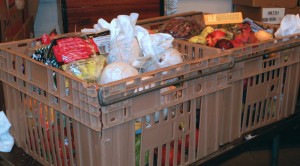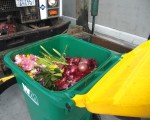Source reduction, diverting for reuse and composting are the best combined practices for food scraps management. This article highlights food donation potential in the City of San Diego.
Ana Carvalho
BioCycle March 2013, Vol. 54, No. 3, p. 33


San Diego is the seventh largest city in the U.S. It is also part of San Diego County, ranked by Feeding America’s Map the Meal Gap 2012 as the seventh county in the U.S. with the highest number of food insecure individuals in 2010. According to Feeding America, 14.8 percent of the region is in the food insecure individuals category.
As the City of San Diego (City) expands its commercial food scraps composting program from the current 60 participants, this alarming data is always in mind, and used to educate about the importance of source reduction and food reuse before composting. Unfortunately, some participants still fear the food reuse option. Although some do reuse their edible food excess, in a recent analysis of our program we calculated that if at least 15 percent of current participants’ food waste was edible and diverted for reuse instead of composting, approximately 666 tons/year of food would be available for food insecure residents and/or other reuse options such as animal feed.

With 14.8 percent of the San Diego region in the food insecure individuals category, increasing food donation is an integral part of the city’s organics program.
Albertsons Grocery Case Study
This ideal food scraps diversion loop is now being achieved in the City of San Diego through Albertsons Grocery Stores and Feeding America Food Bank’s programs. Albertsons first repurposes the excess food, such as turning unsold daily bread into garlic bread or croutons, or unsold rotisserie chicken into chicken salad. Food that can’t be repurposed in the stores is donated to the San Diego Feeding America Food Bank (FAFB) through its Fresh Rescue Program. The stores only compost the remaining inedible food scraps. The San Diego FAFB donates the food to people in need, composting a very small portion of what it receives.

Food that cannot be donated, along with floral waste, is diverted to composting from a San Diego grocery store.
It is understandable that many food scraps generators are hesitant to participate in a food donation program. They need to be informed about the Bill Emerson Good Samaritan Act passed by Congress in 1996 protecting donors of nonperishable and prepared foods, such as manufacturers, growers, restaurants, corporate cafeterias and caterers, from being prosecuted for liability. This Act is the last piece that allows food generators to participate in the perfect food scraps diversion loop.
Ana Carvalho is an Environmental Specialist with the City of San Diego (CA) Environmental Services Department.
Correction: July 1, 2015
County of San Diego estimate for number of meals afforded by a donation rate of 15 percent corrected to 2.5 meals/individuals/year










